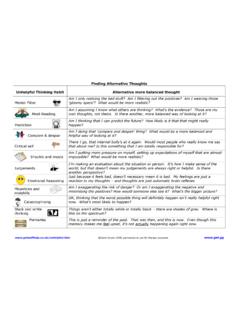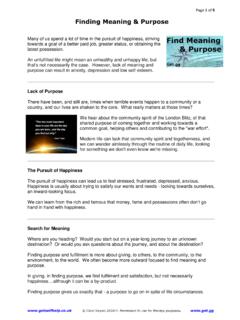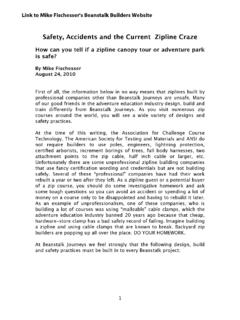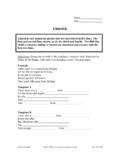Transcription of GENERALISED ANXIETY DISORDER & WORRY
1 Carol Vivyan 2015. Permission to use for therapy purposes. GENERALISED ANXIETY DISORDER & WORRY GENERALISED ANXIETY DISORDER (GAD) is a general, long-lasting WORRY and ANXIETY about everyday life, about anything and everything. People with GAD imagine the worst happening (and WORRY about all the possible worst case scenarios). They believe future events are almost always negative, and they won't be able to cope 'when' these things 'do' happen. However, as in all ANXIETY , we tend to over-estimate the danger, and under-estimate our ability to cope. WORRY is the main problem, but there are other specific aspects to the ANXIETY that occur with GAD: WORRY about current problems and hypothetical situations, WORRY about WORRY , intolerance of uncertainty, cognitive avoidance and lack of problem solving skills. WORRY There are two main types of WORRY .
2 Type 1 worries relate to feared future events. These worries are further broken down (more info in The WORRY Tree) into worries about: Current problems (things I can do something about - and can therefore learn to problem solve) Hypothetical situations (things I can't do anything about - and can therefore learn to react to differently) Use The WORRY Tree to help you deal with type 1 worries. Carol Vivyan 2015. Permission to use for therapy purposes. Type 2 worries are " WORRY about WORRY " which can be both positive and negative. Negative beliefs about WORRY : I might lose all control The WORRY will drive me crazy Positive beliefs about WORRY (the beliefs are negatively reinforced because the imagined feared event doesn't happen and we therefore don't discover that our beliefs are not true): Worrying keeps me (and others) safe Worrying helps me prepare for all the possible worst case scenarios Worrying means I'm a caring person Worrying means I'll cope better when the worst happens Use the Thought Record Sheet for WORRY Beliefs to help you deal with type 2 worries.
3 Set WORRY zones or postpone your WORRY to take control of your WORRY & discover that you don't need to WORRY all the time. INTOLERANCE OF UNCERTAINTY An 'intolerance of uncertainty' means that the person with GAD will WORRY about an imagined feared event as long as there is even the slightest risk of it happening. Examples of thoughts: There's always a risk of something terrible happening I have to be 100% sure! I can't tolerate not knowing The worst could happen Uncertain events are almost always negative Vicious cycle of intolerance of uncertainty Use the APPLE acronym to help you deal with uncertainty. ACKNOWLEDGE - Notice and acknowledge the uncertainty as it comes to mind. PAUSE - Don't react as you normally do. Don't react at all. Just pause, and breathe. PULL BACK - Tell yourself this is just the WORRY talking, and this apparent need for certainty is not helpful and not necessary.
4 It is only a thought or feeling. Don't believe everything you think! Thoughts are not statements of fact. LET GO - Let go of the thought or feeling about needing certainty. They will pass. You don't have to respond to them. You might imagine them floating away in a bubble or cloud. EXPLORE - Explore the present moment, because right no, in this moment, all is well. Notice your breathing, and the sensations of breathing. Notice the ground beneath you. Look around and notice what you see, what you hear, what you can touch, what you can smell. Right now. Then, SHIFT YOUR FOCUS OF ATTENTION to something else - on what you need to do, on what you were doing before you noticed the WORRY , or do something else - mindfully, with your full attention. Carol Vivyan 2015. Permission to use for therapy purposes. Example of a vicious cycle of GAD & WORRY SUMMARY Therapy for GAD focuses on: identifying and acknowledging the WORRY learning to differentiate between different kinds of WORRY (The WORRY Tree) challenging the unhelpful beliefs about WORRY (Thought Record Sheet for WORRY Beliefs) Reducing WORRY by learning to set WORRY zones or Postpone WORRY developing problem solving skills increasing tolerance of uncertainty and the associated discomfort of ANXIETY learning attention training or mindfulness skills You can use STOPP skill to incorporate all these techniques, STOP - just pause for a moment Take a breath - one slow deep breath Observe - there's that WORRY again.
5 My body is reacting to those thoughts and I feel anxious. Pull back - this is just the mind bully / GAD talking. I don't have to react right now. Is this a current problem or one of those hypothetical situations? ( WORRY Tree) I can use APPLE technique for dealing with uncertainty. Another way of looking at this WORRY Practise / Proceed - What can I do right now? I can use APPLE (uncertainty), WORRY Tree (type 1 WORRY ), Thought Record Sheet for WORRY Beliefs (type 2 " WORRY about WORRY "), Problem solving worksheet, Postpone my WORRY etc. Where can I put my focus of attention - what else can I















